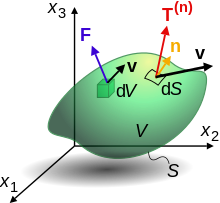Relativistic

Lorentz invariance
Newtonian physics assumes that absolute time and space exist outside of any observer; this gives rise to Galilean invariance. It also results in a prediction that the speed of light can vary from one reference frame to another. This is contrary to observation. In the special theory of relativity, Einstein keeps the postulate that the equations of motion do not depend on the reference frame, but assumes that the speed of light c is invariant. As a result, position and time in two reference frames are related by the Lorentz transformation instead of the Galilean transformation.
Consider, for example, one reference frame moving relative to another at velocity v in the x direction. The Galilean transformation gives the coordinates of the moving frame as
while the Lorentz transformation gives
where γ is the Lorentz factor:
Newton's second law, with mass fixed, is not invariant under a Lorentz transformation. However, it can be made invariant by making the inertial mass m of an object a function of velocity:
m0 is the object's invariant mass.
The modified momentum,
obeys Newton's second law:
Within the domain of classical mechanics, relativistic momentum closely approximates Newtonian momentum: at low velocity, γm0v is approximately equal to m0v, the Newtonian expression for momentum.
Four-vector formulation
In the theory of special relativity, physical quantities are expressed in terms of four-vectors that include time as a fourth coordinate along with the three space coordinates. These vectors are generally represented by capital letters, for example R for position. The expression for the four-momentum depends on how the coordinates are expressed. Time may be given in its normal units or multiplied by the speed of light so that all the components of the four-vector have dimensions of length. If the latter scaling is used, an interval of proper time, τ, defined by
is invariant under Lorentz transformations (in this expression and in what follows the (+ − − −) metric signature has been used, different authors use different conventions). Mathematically this invariance can be ensured in one of two ways: by treating the four-vectors as Euclidean vectors and multiplying time by √−1; or by keeping time a real quantity and embedding the vectors in a Minkowski space. In a Minkowski space, the scalar product of two four-vectors U = (U0,U1,U2,U3) and V = (V0,V1,V2,V3) is defined as
In all the coordinate systems, the (contravariant) relativistic four-velocity is defined by
and the (contravariant) four-momentum is
where m0 is the invariant mass. If R = (ct,x,y,z) (in Minkowski space), then
Using Einstein's mass-energy equivalence, E = mc2, this can be rewritten as
Thus, conservation of four-momentum is Lorentz-invariant and implies conservation of both mass and energy.
The magnitude of the momentum four-vector is equal to m0c:
and is invariant across all reference frames.
The relativistic energy–momentum relationship holds even for massless particles such as photons; by setting m0 = 0 it follows that
In a game of relativistic "billiards", if a stationary particle is hit by a moving particle in an elastic collision, the paths formed by the two afterwards will form an acute angle. This is unlike the non-relativistic case where they travel at right angles.
The four-momentum of a planar wave can be related to a wave four-vector
For a particle, the relationship between temporal components, E = ħ ω, is the Planck–Einstein relation, and the relation between spatial components, p= ħ k, describes a de Broglie matter wave.















Comments
Post a Comment